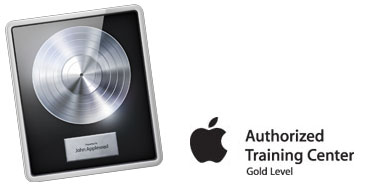Logic 101 - Introduction to Logic Pro
Select a date to register.

Course Description
This three-day hands-on course introduces students to the primary features and basic user interface of Logic Pro. Attendees will learn how to generate a customized audio and MIDI configuration that will seamlessly integrate with their own personal production studio. Students will also create their own song using a comprehensive array of software instruments, Apple Loops, and DSP effects. The in-depth lessons cover MIDI and audio recording; streamlined editing, mixing, and arrangement techniques; user defined key commands; automation; using external MIDI controllers; and creating final output.
Certification Exam Participants take an exam to earn Apple Certified Pro - Logic Pro status.
the primary features and basic user interface of Logic Pro. Students learn how to generate a customized audio and midi configuration that will seamlessly integrate with their own personal production studio. Students also create their own song using Logic Pro's comprehensive array of software instruments, Apple Loops and DSP effects. In-depth lessons will cover MIDI and audio recording, streamlined editing and arrangement techniques, user defined key commands, automation, scoring to picture and surround mixing.
Objectives
This Logic Pro course teaches students the following skills:
- Understanding workflow techniques
- Recording and editing audio and MIDI
- Using software instruments
- Working with audio effects
- Mixing and automation
- Manipulating pitch and time
Who Should Attend?
This class is designed for those who want to learn music production and composition using Logic Pro.
Prerequisites
Students should have the following prerequisite knowledge prior to attending the course:
- Basic knowledge of Mac OS
- Basic knowledge of audio terminology is recommended
Course Outline
Note: The curricula below comprise activities typically covered in a class at this skill level. The instructor may, at his/her discretion, adjust the lesson plan to meet the needs of the class.
Day 1
Lesson 1: Make Music with Logic Now!
- Creating a Logic Pro project
- Exploring the interface
- Navigating the project
- Building up the arrangement
- Mixing the song
- Mixing down to a stereo file
Lesson 2: Recording Audio
- Setting up digital audio recording settings
- Recording a single track
- Recording additional takes
- Punching in and out
- Recording without a metronome
- Changing recording settings
- Deleting unused audio files
Lesson 3: Editing Audio
- Assigning mouse tools
- Editing regions in the workspace
- Comping takes
- Adding fades and crossfades
- Editing regions in the audio track editor
- Aligning audio
Lesson 4: Produce a Virtual Drum Track
- Creating a Drummer Track
- Arranging the Drum Track
- Customizing the Drum Kit
Day 2
Lesson 5: Recording MIDI and Using Controllers
- Using a Patch from the Library
- Recording MIDI
- Correcting the Timing of a MIDI Recording
- Joining Recordings into a MIDI Region
- Recording MIDI Takes
- Punching In and Out
- Creating a Layered Sound Patch
- Mapping Smart Controls to Patch Parameters
- Processing MIDI Notes with MIDI Plug-Ins
Lesson 6: Creating and Editing MIDI
- Creating MIDI Notes in the Piano Roll Editor
- Using the brush tool and custom brush patterns
- Using time handles
- Quantizing MIDI regions and notes
- Importing a MIDI File
- Editing MIDI Data in the Event List
- Creating and Editing MIDI Continuous Controller
Lesson 7: Editing Pitch and Time
- Setting a Project Tempo by Detecting the Tempo of a Recording
- Using and Creating Apple Loops
- Creating Tempo Changes and Tempo Curves
- Matching an audio file to the project key and Tempo
- Adding a Turntable or Tape Slow-Down Effect
- Making One Track Follow the Groove of Another Track
- Change the Playback Pitch and Speed with Varispeed
- Editing the Timing of an Audio Region
- Tuning Vocal Recordings
Day 3
Lesson 8: Editing an Arrangement
- Looping regions and converting loops to individual regions
- Packing regions into a folder
- Saving alternative arrangements
- Previewing the song
- Copying material to fill in parts
- Rendering multiple regions
- Adding and deleting sections
- Cutting regions to remove silence or noise
Lesson 9: Mixing
- Organizing Windows and Tracks
- Using the Amp Designer
- Adjusting Levels and Pan
- Submixing tracks and processing with bus sends and auxiliary channel strips
- Applying effects to a selected section of a track
- Using folder and summing stacks
- Using screen sets
- Filtering frequencies with an EQ plug-in
- Adding depth with delay and reverb plug-ins
- Using Compressor and limiter plug-ins
Lesson 10: Automating the Mix
- Creating and editing offline track and region automation
- Recording Live Automation
- Using MIDI Controllers
- Bouncing the Mix
Lesson 11: Mixing in Dolby Atmos
- Setting up for Dolby Atmos
- Creating Bed and Object tracks
- Panning Tracks in Surround
- Using 7.1.2 Audio Effect Plug-Ins
- Automating the Mix
- Exporting the ADM BWF Master File